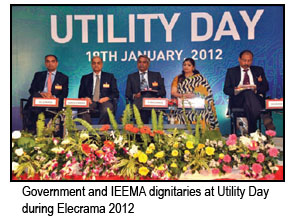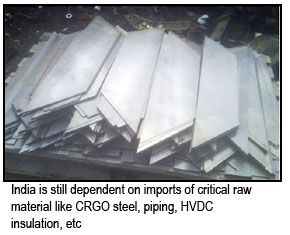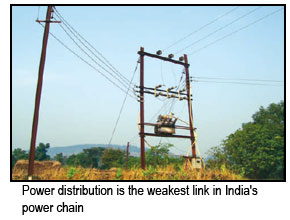
Sushilkumar Shinde, Union power minister, appeared to
be very pleased with the performance of his ministry
during the past five to six years, but accepted that "we
have a long way to go." India's per capita power consumption
is currently 800 kwh per year, which is around one-tenth of
that in developed countries. While Shinde issued laudatory
remarks on the way the power generation capacity has
performed, he was wary and even critical of the power
distribution sector. "Distribution losses have to be seriously
looked into," was just one of the several observations he made
on this crucial last-mile segment in the power value chain.
On the generation front, the minister was more than happy
to note that the country was going to add 51,000 mw of new
power generation capacity from conventional sources alone,
during the XI Plan period. This is over and above 14,000 mw of
new capacity from renewable energy sources and 12,000 mw
from captive power plants. During FY11 alone, he asserted,
the country could add as much as 12,000 mw of new capacity.
"There was a time when the country could add only 8,000 mw
to 10,000 mw in an entire five-year Plan period," he noted with
satisfaction. He also observed that over 80,000 mw of new
power generation capacity was currently under construction.
With respect to power generation capacity, the role of
private sector has been exemplary. In the X Plan period (2002-
07), private sector had a share of 10 per cent in new power
generation capacity added. This is expected to grow to 32 per
cent in XI Plan period and further to 52 per cent in the XII Plan
period (2012-17), Shinde observed. While power generation
capacity is increasing at a satisfactory pace, the shortage of
subcontractors and manpower for maintenance works,
remain as areas of concern. Shortage of balance-of-plant
contractors for thermal power plants was a very serious issue,
he noted.
Untitled Document
Coal, gas and environment |
| While Shinde repeatedly noted that power generation capacity
has grown as a very healthy rate, he expressed concern that fuel
supplies-coal and gas-have not kept pace. "Coal and gas are not
matching us (power sector)," he asserted. Shinde sought firm
coal linkages for power projects and cautioned that if linkages
were not in place, financing of new projects was in peril. For
completed coal-fired plants, the minister said that he was keen
that firm fuel supply agreements (FSA) are signed. Delays in
environmental clearances are causing hardships on many frontsnot
just for new power generation projects but also exploration of
new coal mines. Domestic coal production has fallen
considerably short of targets, government statistics indicate. |
COMPETITIVENESS & COMPETITION
Shinde stressed on the need of building capacity in the BTG
segment, asserting that India's development hinges on
growth of its power sector. He was pleased that India was
now in a position to export main plant equipment, a situation
that was quite unthinkable say five to seven years ago. While
domestic mainstay Bharat Heavy Electricals Ltd is ramping up
its manufacturing capacity from 5,000 mw to 20,000 mw per
year, there are several entities (joint ventures between Indian
and multinationals) that are setting up manufacturing
facilities in the country for supercritical BTG equipment.
Admitting that there is a threat from imports, he assured
domestic companies of government support. "You are bound
to get our protection," Shinde said.
In his address, Ramesh D. Chandak, President, IEEMA,
observed that India's investment in power T&D is lacking.
While in developed countries, investment in T&D is one and a
half times that in generation, in India the ratio was barely 1:1.
Chandak noted that though T&D players have contemporary
technology and have established themselves globally, the
built-up capacity stands under utilized across several
products, as there has been a surge in imports. Requesting the
government to create a level-playing field for domestic
manufacturers, Chandak noted, "Domestic electrical
equipment manufacturing industry is at a substantial
disadvantage vis-à-vis imports, which is impacting the
commercial viability of the industry and would have long
term consequences."
The "level-playing field" requirement in the context of
imports was echoed by several manufacturers during the
interactions that Electrical Monitor had with exhibitors at
Elecrama 2012. Several domestic transformers manufactures
said that they were not concerned with Chinese players
establishing manufacturing base in India, but were
apprehensive of cheap imports from China. The Chinese
government supports exports through fiscal benefits
resulting in lower landed costs in India. This hurts domestic
suppliers. However, if Chinese companies set up shop in India,
they will be at par with Indian counterparts. "We have no
problems with a Chinese company setting up a
manufacturing plant in India and competing with us
(domestic manufacturers). We welcome such fair
competition," a Hyderabad-based transformer maker told
Electrical Monitor.
While Shinde abundantly assured protection to domestic
companies from cheap imports, he was also sympathetic to
the criticality of imported BTG equipment in meeting
India's XI Plan targets. While there is a possibility of the government levying countervailing duty on imported
equipment, to protect domestic manufacturers like BHEL,
Larsen & Toubro, and the several JVs coming up, there could
be a duty exemption on equipment already ordered by
private power producers for commissioning in the XI Plan
period. "We have to protect those power producers that have
placed orders on foreign suppliers in the XI Plan," the
minister said.

In his note on Industry Day, B. P. Rao, CMD, Bharat Heavy
Electricals Ltd made very interesting observations on Indian
competitiveness and the true challenges that the Indian
power equipment industry faces. He noted that it was time
India moved away from cost-led competitiveness to
innovation-led competition. "Competition is still on the
basis of low-cost of production. We have still to move to the
plane of competition based on innovation," Rao observed.
Citing the example of his own company, the CMD said that
BHEL now spends 2.5 per cent of its sales on R&D, which is
amongst the highest in the industry. The public sector
engineering company is also filing patents at the rate of
almost one per day. Yet, as Rao admitted, it was way below
the standards of global giants.
Untitled Document
Limit on UMPP developers |
While responding to a question on the broad status of ultra
mega power projects, Union power minister Sushilkumar
Shinde expressed satisfaction at the government's initiative
of launching ultra mega power projects. He said that the endeavour
had even won the appreciation of the international community. From
2006 onwards, four UMPPs have been awarded and this was a
commendable performance, the minister felt. When asked about his
view on the fact that out of the four UMPPs, three have gone to the
same developer, he said that the government has now decided to limit
the number of UMPPs to be awarded to a single developer to three.
This could imply that Reliance Power (Anil Ambani Group) would not
be eligible to bid for more UMPPs. Reliance has won three UMPPs—
Sasan, Krishnapatnam and Tilaiya—while the Mundra UMPP has
gone Tata Power's way. The minister also noted that progress on the
UMPPs in Orissa and Chhattisgarh was hampered by environmental
clearances. However, with the recent clearance to the Orissa project,
there should be forward movement in the near future, he felt.
On the question of the financial viability given the increase in
prices of imported coal, Shinde said that talks were on with
ambassadors of coal-exporting countries like Indonesia. "We will do
our best to resolve the issue," was what he had to say. It may be
mentioned that Indonesia recently decided to export coal only at
market-related prices thereby affecting the financial viability of
UMPPs. Developers of the coastal Krishnapatnam and Mundra
projects had contracted to buy coal at much lower rates, backed by
long-term purchase agreements. The increase in coal prices could
very much affect the tariffs quoted by the developers whilst wining
the projects. Increase in coal prices could put a big question mark on
the financial viability of the UMPPs, especially those designed to run
on imported fuel.
|
On China too, Rao made some profound observations. He
explained that China's so-called dominance was not the result
of innovation but on that country's ability to create a local
value chain. Having the complete production value chain has
brought down China's cost of production to globally competitive
levels.
Back home, there were many challenges on the power
equipment production front. Rao said that the industry was
still dependent on key imported material like CRGO steel,
large diameter piping, HVDC insulation material, etc. "It puts
industry at a disadvantage not just with respect to costs but
also lead time." Rao pointed out that India's domestic power
generation capacity is expected to nearly double from the
current 1.86 lakh mw, by 2017. This would need concerted
effort on the part of all stakeholders. Apart from import
dependence, India also faced challenges in terms of infrastructure inadequacies. Slow ODC movement, due to
infrastructure (logistics) bottlenecks, results in higher cycle
time, he said. He also dwelt on lack of domestic testing
facilities due to which high-voltage equipment needs to be
sent overseas for testing, resulting in higher lead times.
On the subject of competitiveness, Rao exhorted industry
players to become global names. "The industry is largely
driven by local demand. We have failed to make a mark in the
global market." On the much-debated topic of government
support to the industry, Rao assured, "Industry has clarified
several times. We don't need support; we need a level-playing
field. We want protection from taxes, not from competition!"
S. Sundaresan, Secretary, Union Ministry of Heavy
Industries also admitted that Indian manufacturers need to
benchmark their products on global standards. He noted that
the equipment manufacturing sector faces several challenges
like dependence on imports for crucial raw material, shortage
of manpower, low R&D expenditure, lack of planning,
skewed procurement policies, etc. In this brief keynote
address, Sundaresan noted that the "Brand India" endeavour
has not received the desired policy attention.
Untitled Document
National Electricity Fund |
The Union government has recently approved the National
Electricity Fund with a view to encourage reforms-based
progress at the state government-level. NEF will be initially taken
up for two years on pilot basis. This programme will be a reformsbased
initiative where eligibility for entry (access to assistance
under NEF) will be determined by the reforms-related performance
of state power distribution utilities. Benefits in terms of interest
subsidies will be available to participating utilities on the basis of
achieving further parameters of reforms, mainly reduction in ATC
losses. In the first two years, utilities would borrow Rs.25,000
crore from FIs and banks, and they will help in strengthening the
distribution system and closing the gaps between achievement
and target under flagship programmes like R-APDRP and RGGVY. |
DISTRIBUTION IS THE WEAK LINK
Sushilkumar Shinde noted at regular intervals in his keynote
address and press briefing that the power distribution sector
was in poor state. "Distribution is the most critical element of
electricity but has been widely ignored. The heart of the
power sector lies in efficient management of the distribution
sector," he explained.

The minister appeared worried about the high ATC
(aggregate technical and commercial) losses. Though such
losses have come down from about 39 per cent in FY02 to 27
per cent in FY10, the government would ideally like them to
be lower than 15 per cent. "We are not happy," he said, adding
that even foreign investors are appalled at the state of India's
power distribution sector. While measures under the RAPDRP
project as also modern technology is expected to bring
down ATC losses, the efforts need to be redoubled.
Shinde also elaborated on the government's intention of
firstly understanding the nature of these ATC losses. Various
industry and government reports have placed combined
losses of state-owned power utilities between Rs.50,000 crore
to Rs.80,000 crore. "These losses need to be understood," the
minister noted. To this effect, the power ministry is planning
to appoint an independent (non-government) investigator to
know the break-up of these losses-commercial losses,
technical losses, power theft, free power, etc. On the subject
of free power, the minister accepted that while the Electricity
Act, 2003 does have a provision for free power, utilities are not
exercising discretion. Utilities need to make budgetary
provisions for such free power, a practice not fully adhered to
currently, he noted.
Shinde also pointed out to mismanaged practices by power
utilities with respect to tariffs. Increasing of power tariffs, as
also envisaged by the Electricity Act, 2003, needs to be an
"automatic" process. Several power utilities have not
increased tariffs for as many as seven years and when they did,
there was immense resistance from consumers. Such
situations can be avoided. Meanwhile, it is reliably learnt that
state electricity regulatory commissions are expected to
penalize distribution companies that fail to annually revise
tariffs. Shinde also appreciated that some utilities have
started increasing tariffs even at six-monthly intervals. "I
think this is a good sign," he observed.
Shinde was also appreciative of private sector enterprise in
power distribution, noting the smart turnaround in erstwhile
loss-making circles like Bhiwandi (Maharashtra), Agra,
Kanpur (both UP), etc. The ATC losses in many privatized
circles have reduced to single-digit levels. Even due to
measures envisaged under R-APRDP, ATC losses in over 200
populous towns have come down to as low as 5 per cent,
Shinde commented.
In his keynote address, Devendra Singh, Joint Secretary-
Distribution, Ministry of Power, admitted that the power
distribution sector was not in the best of health with
cumulative losses exceeding Rs.1 lakh crore. There are gaps
between recovery and cost of supply, and the losses are well in
the high double-digit range.
CRITICAL PHASE FOR TRANSMISSION
R.N. Nayak, CMD, Power Grid Corporation of India made
very emphatic statements about the power sector, suggesting
that the critical growth phase will be from 2012 onwards.
Over the past five years, the power sector has seen drastic
changes. Prognosticating on the XII Plan period and onwards,
Nayak said that supercritical technology will be the norm for
coal-fired power plants and that 400kV transmission lines,
considered as EHV lines currently, will be treated nothing
more than "sub-transmission" infrastructure.

Transmission networks will need to be augmented rapidly
given the growth in electricity load in urban areas. Some
cities, as Nayak observed, have seen a load growth of 15 per
cent, which is phenomenal compared to that seen in even
developed countries. He explained that with India's per capita
consumption still very low, such high growth in power
consumption would be but obvious.
Nayak said that by March 2012, at least 1,000 km of 800kV
AC lines and around six 765kV substations would be set up.
PGCIL currently has 90,000 ckm of transmission lines in the
country's total of some 2.5 lakh ckm. The PGCIL chairman
also noted that construction of India's first 800kV DC line has
started and completion is expected over the next 30 months.
Among other achievements, Nayak highlighted India's
movement to 1,200kV UHVAC power transmission
infrastructure (See Box) and also PGCIL's involvement in the
Smart Grid project.
Untitled Document
POWR OUTLAY: XII PLAN |
| |
1.8 |
| Generation |
6.0 |
| Transmission |
1.8 |
| Distribution |
5.0 |
| Total |
12.8 |
With power transmission infrastructure getting more
intricate, conventional methods and thinking might not work. He citied the example of maintenance of transmission
towers that is now being done with the help of helicopters. In
the near future, PGCIL will be inviting international bids for
helicopter-based maintenance of its transmission network.
He also alluded to the strong possibility of remote
maintenance of EHV substations, without human
intervention. Nayak explained that substations will be
monitored remotely through online systems. Except for
physical security, there will be no human intervention in
substation maintenance. In the next 18 months, PGCIL
expects that most of its EHV substations will be remotely
maintained. On another note, PGCIL also expects to
commission two mobile substations of 315MVA/400kV. This
will help in quick replacement of substations needing repair.
On PGCIL's investment in the XII Plan period, Nayak said
that the Central transmission utility expects to see an
investment of $28-30 billion over the next 5-6 years. PGCIL
expects to add another 70,000 ckm to its existing
transmission network of 90,000 ckm, by March 2017. At
least 80 more EHV substations will be built, growing from
the 145 existing currently.
OUTLOOK FOR XII PLAN
P. Uma Shankar, Secretary, Ministry of Power, summarized
the performance of the power sector in the XI Plan and
charted possible courses of action for the ensuing Plan period.
In the XII Plan period (2012-17), India is expected to add
76,000 mw of new power generation capacity as compared
with around 52,000 mw in this Plan period. Further, over 50
per cent of the incremental power generation capacity in the
XII Plan period will be from the private sector. Uma Shankar
also observed that over 40 per cent of India's new power
generation capacity in the XII Plan period will be based on
supercritical technology.

In the transmission sector, 69,000 ckm of 220kV lines are
expected to be added, which is broadly in tune with the target.
In the XII Plan, the addition is targeted to be 1 lakh ckm. In
terms of inter-regional transfer capacity (IRTC), the
cumulative achievement up to March 2012 will be twice the
level of March 2007. In the XII Plan, 58,000 mw of new IRTC
is being planned that would once again double the
outstanding level between March 2012 and March 2017.
The investment in power generation in the XII Plan is likely
to be Rs.6 trillion, followed by transmission with Rs.1.80
trillion and distribution with Rs.5 trillion. This, as many
industry experts point out, will be the first time that
investment in T&D will surpass that of generation.
The power secretary also pointed out that flagship schemes
like R-APDRP and RGGVY will continue in the XII Plan
period. RGGVY, which is currently at the village-level, will be
taken to the habitation level during the next Plan period. RAPDRP
will see a lowering of its threshold limits thereby
extending itself to many more towns, the Secretary noted.
Uma Shankar highlighted the growing contribution of
renewable energy capacity. In the XII Plan, around 13,000 mw
of new renewable capacity is expected, to be followed by
30,000 mw in the XIII Plan. To support the 43,000 mw of such
capacity over the next decade, the power ministry has
planned to strengthen the inter-state transmission network,
particularly with respect to renewable energy-rich states like
Tamil Nadu, Punjab, Maharashtra, etc. Financing the
proposed inter-state transmission system will be supported
through measures like capital subsidy and viability gap
funding (VGF) mechanism.
In all the deliberations at Elecrama 2012, it came out very
strikingly that the XII Plan period will define a paradigm shift
in India's power sector. Across all parameters—policy
framework, reforms process, physical performance and
building local competencies—the XII Plan has much in store.
India has done reasonably well—if not exceedingly well—in
the XI Plan period and the ensuring Plan period will hopefuly
be an improved furtherance of the current effort.
Untitled Document
India moves to 1,200kV |
India will soon have the rare distinction of having the highestrating
power transmission system in the world. On January 27,
2012, PGCIL was set to inaugurate the 1,200kV UHVAC test
station at Bina in Madhya Pradesh. In his address, R. N. Nayak,
CMD, PGCIL was very appreciative of the effort and lauded
domestic suppliers to have contributed to this landmark
development. Nayak reminisced that when 1,200kV infrastructure
was conceived in 2006, it was never expected that it could be
done entirely through indigenous technology. However, he noted
that the entire gamut of equipment, from clamps and connectors
to power transformers,was supplied by Indian manufactures.
Nayak also observed that some companies supplied equipment
without any financial charge, treating it as contribution for a
national objective. |